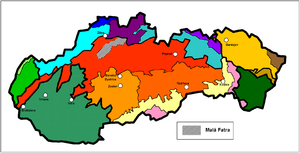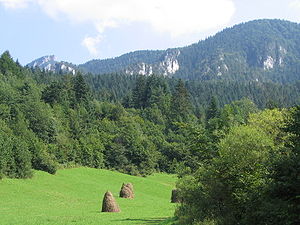Little Fatra
| Little Fatra | ||
|---|---|---|
|
Veľký Rozsutec limestone mountain (1,610 m) |
||
| Highest peak | Veľký Kriváň ( 1709 m nm ) | |
| location | Slovakia | |
| part of | Western Carpathians | |
|
|
||
| Coordinates | 49 ° 11 ′ N , 19 ° 2 ′ E | |
The Little Fatra (Slovak Malá Fatra ) is a 55 kilometer long mountain range in the north-western part of Slovakia , southeast of the town of Žilina in the course of the Carpathian Arc .
The main ridge runs from southwest to northeast and is broken through in the middle of the mountains by the Waag ( Váh ). At this point the river and the mountain slopes form a 12-kilometer-long bottleneck, called Strečnianska tiesňava (German bottleneck of Strečno). In the Middle Ages , the trade routes through the narrow pass through the castles Starý hrad and Strečno were guarded. The bottleneck divides the Little Fatra into two parts:
- the Krivánska Fatra in the north (named after the highest mountain Veľký Kriváň , 1709 m)
- the Lúčanská Fatra in the south (named after the highest mountain Veľká Lúka , 1476 m)
The Little Fatra is limited
- in the north of the Kysucká vrchovina ,
- to the east from the river Orava and the valley Turčianska kotlina ( Turzbecken )
- in the south of the Strážovské vrchy mountains in the Fačkovské sedlo and mountain pass
- the west by the valley Žilinská kotlina ( Žilina Basin ).
geology

The geological composition of the mountains is quite diverse. The Lúčanská Fatra and the southern main ridge of the Krivánska Fatra consist largely of granite . Accordingly, the surface is less structured.
The northern main ridge of the Krivánska Fatra and its northern and eastern side ridges contain large proportions of limestone , dolomite , quartzite and sandstone . The rock types often change in a small space.
The limestone encouraged the emergence of numerous karst features , which, however, are less spectacular than in other regions of the country and not accessible to the public (e.g. Kryštálová jaskyňa ).
Flora and fauna
The Little Fatra is - apart from the higher areas and the pastures - densely forested. Here dominate Book and other deciduous trees. Monocultures of spruce , on the other hand, are comparatively rare. Mountain pines grow widespread at higher altitudes . The main ridge is mostly grass-covered.
The rocks, which change in a small area in many places, produce a varied plant cover with a large number of - even rarer - species.
The diversity of the vegetation also favors a large number of species in the animal kingdom, especially butterflies and beetles . In addition to the more common game species - roe deer , wild boar and deer - brown bears , lynxes , stone marten and otters can also be found in the mountains . On the ornithological side , besides birds of prey ( wasp and common buzzard , sparrowhawk , hawk ), various species of owls are worth mentioning.
population
The mountains themselves are only inhabited to a limited extent. With Štefanová there is only one place in the interior of the Little Fatra in the traditional sense. In contrast, the immediate area is quite densely populated.
The inhabitants of the region are almost exclusively Slovaks . The settlement of Wallachian shepherd families - especially in the north of the Little Fatra - during the 15th and 16th centuries is interesting . However, these were assimilated by the Slovak majority within a few generations .
The relative seclusion, especially of the northern part of the mountain, favored the persistence of some elements of folk culture ( costumes , dances), albeit with a clearly declining trend. In contrast, in many places there are still numerous living examples of Slovak folk architecture (e.g. wood-clapboard houses).
economy
The most important industry in the mountains is tourism (see below).
Forestry and grazing
are also of greater importance . Arable farming is only possible to a limited extent due to the strong structure of the terrain with many slopes.
The larger towns on the edge of the mountains are currently benefiting from the economic boom in Slovakia. For example, the KIA group built a large car plant in the town of Mojš near Žilina , which started production in April 2007.
tourism
Little Fatra is one of the most important tourist regions in Slovakia. The Krivánska Fatra plays the bigger role. The most important tourist center is the Vrátna Valley ( Vrátna dolina in Slovak ). A number of the peaks surrounding this valley are rocky. The jagged limestone mountain Veľký Rozsutec (1610 m) stands out among them ; it is one of the botanically richest localities in Slovakia. From the Vrátna Valley, the highest peak in the mountains - Veľký Kriváň - can be reached relatively easily by means of a cable car that went into operation in 2006 . Wild rocky gorges and gorges formed in the limestone areas; so there is a 38 meter high waterfall near Šútovo . Other important tourist spots in this part of the Little Fatra are Terchová , the birthplace of Juraj Jánošík , and Zázrivá .
The Lúčanská Fatra is a little less known. The central part of this region - the Martinské hole not far from the city of Martin - is the most frequently visited; here is the second larger ski area of the Little Fatra, next to the Vrátna valley. From the summit region of the highest mountain - the Veľká Lúka - a broad view of the fall basin is possible.
The various health resorts that have settled in the small Fatra due to the good air and the various medicinal springs are significant for tourism .
traffic
The Kleine Fatra is very well developed in terms of traffic. The Žilina – Košice railway (formerly Kaschau-Oderberger Railway ) runs through the Strečnianska tiesňava bottleneck ; in Vrútky the route branches off to the south via Martin to Zvolen . Finally, on the north-western edge of the mountains, there is a small regional connection from Žilina to Rajec .
Buses run to all of the larger towns on the edge of the mountains. Some mountain settlements in the north of the Krivánska Fatra can only be reached on unpaved roads or even only on footpaths.
The fastest route from German-speaking countries to Little Fatra is via Prague or Bratislava. From there there are direct express trains to Žilina and Vrútky, among others . In addition to the Slovak State Railways, travelers can also choose between the private rail operators Regiojet (from Prague and Bratislava) and Leo Express (from Prague).
natural reserve
The Little Fatra National Park was established in the mountains in 1988 ; its size is 226.3 km². It lies exclusively in the area of the Krivánska Fatra. A number of areas inside and outside the national park have been placed under special protection:
- Národné prírodné rezervácie (NPR, National Nature Reserves )
- Chleb (412.87 ha, since 1967)
- Kľačianska Magura (204.47 ha, 1976)
- Kľak (85.71 ha, 1966)
- Krivé (203.72 ha, 1979)
- Minčol (96.1 ha, 1980)
- Prípor (272.27 ha, 1980)
- Rozsutec (841.55 ha, 1967)
- Sokolec (199.24 ha, 1980)
- Starý hrad (85.42 ha, 1967)
- Šíp (301.52 ha, 1980)
- Šrámková (243.65 ha, 1967)
- Šútovská dolina (526.65 ha, 1967)
- Suchý (429.42 ha, 1979)
- Tiesňavy (479.21 ha, 1967)
- Veľká Bránica (332.09 ha, 1967)
- Prírodné rezervácie (PR, nature reserves )
- Dubovské lúky (16.03 ha, since 1980)
- Goľove mláky (6.83 ha, 1988)
- Hajasová (7.17 ha, 1976)
- Hrabinka (0.40 ha, 1988)
- Hrádok (6.75 ha, 1976)
- Močiar (8.16 ha, 1993)
- Paráč (45.27 ha, 1980)
- Pod Rígľom (14.23 ha, 1984)
- Veľká Lučivná (66.38 ha, 1967)
- Prírodné pamiatky (PP, natural monuments )
- Bôrická mláka (0.60 ha, since 1974)
- Domašínsky meander (80.37 ha, 1978)
- Kraľoviansky meander (18.23 ha, 1990)
- Krasniansky luh (15.21 ha, 1989)
- Šútovská epigenéza (52.2 ha, 1979)
- Chránené areály (CHA, Protected Areas )
- Hate (0.58 ha, since 2001)
Significant surveys
- Veľký Kriváň , 1709 m
- Chleb , 1647 m
- Veľký Rozsutec , 1610 m
- Stoh , 1608 m
- Veľká Lúka , 1476 m
- Suchý , 1468 m
- Minčol , 1364 m
- Kľak , 1352 m
- Malý Rozsutec , 1343 m
Some places in the mountains and the surrounding area
see also: Fatra , Great Fatra
Web links
- Claus-Peter Lieckfeld : “ Leash off! Hiking holiday with the dog in the Slovak National Park Little Fatra ”, DIE ZEIT No. 27, June 30, 2005



